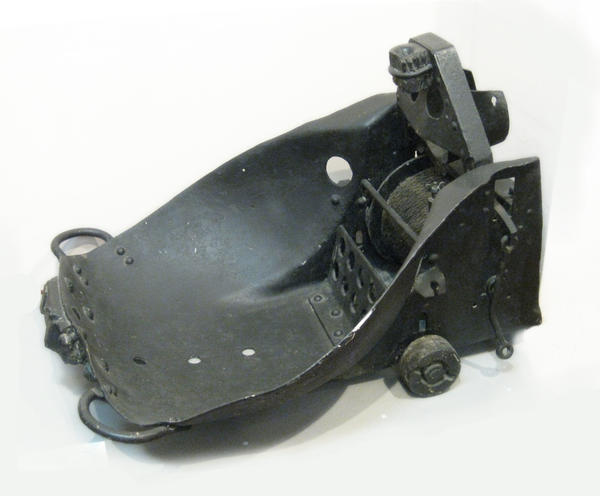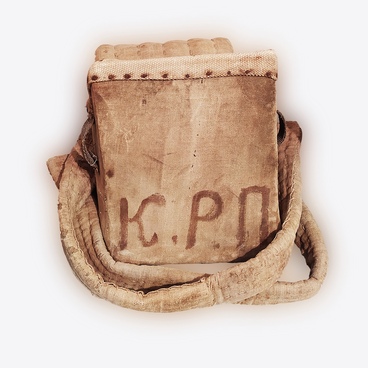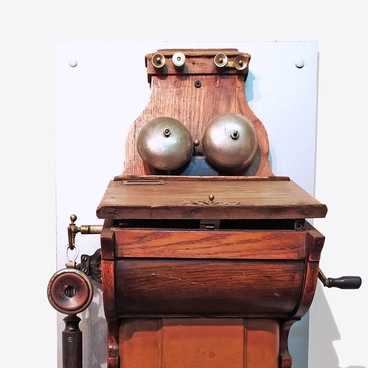This mine cart, presented in the museum’s exhibition, was found in 1968 in a fissure in the Northern Dvina near the village of Róchegdy. It was used by the British interventionists during the Civil War for placing mines in the Northern Dvína. Being in the water at a predetermined level, the mine was invisible — an explosion would take place upon contact with it. Similar carts have been used since the late 19th century.
The 1908 model of the anchor galvanic shock mine was actively used in Russia. The fuse was located on top of the mine, and five galvanic lead caps were placed around the perimeter of the hull. Each bell contained an electrolyte battery in a glass ampoule. When a ship hit a mine, the cap crumpled, the ampoule broke, and the electrolyte activated the battery. The current from the battery fed through to the ignition device and ignited the detonator. TNT was used as an explosive, and the mass of the charge was 115 kg.
To set mines in a given pit, a method proposed back in 1882 by Lieutenant Mykola Azárov, an outstanding innovator in the mine work of the domestic fleet, was used. The essence of the method was as follows. An anchored or trolley-mounted jack was equipped with a special stopper, consisting of a latch, a spring and a loaded cable. When dropped overboard, the mine, which had a positive buoyancy, remained on the surface. Under the action of the load, the cable pulled the latch, and this ensured free reeling of the cable. The anchor would begin to sink. When the load reached the bottom, the tension on the cable relaxed and the latch stopped the jack. Continuing to descend, the anchor carried the mine to a depth that exactly corresponded to the length of the loaded cable.
The procedure for preparing and placing mines had two stages. The preliminary stage was the installation of lead caps, ampoules filled with electrolytes, a safety device, conductors, and checking all electrical circuits. The final stage was only for the installation of the ignition material.
The design of this mine was so successful that after minor modernization in 1939, it remained in service with the Russian fleet until the mid-1960s.
The 1908 model of the anchor galvanic shock mine was actively used in Russia. The fuse was located on top of the mine, and five galvanic lead caps were placed around the perimeter of the hull. Each bell contained an electrolyte battery in a glass ampoule. When a ship hit a mine, the cap crumpled, the ampoule broke, and the electrolyte activated the battery. The current from the battery fed through to the ignition device and ignited the detonator. TNT was used as an explosive, and the mass of the charge was 115 kg.
To set mines in a given pit, a method proposed back in 1882 by Lieutenant Mykola Azárov, an outstanding innovator in the mine work of the domestic fleet, was used. The essence of the method was as follows. An anchored or trolley-mounted jack was equipped with a special stopper, consisting of a latch, a spring and a loaded cable. When dropped overboard, the mine, which had a positive buoyancy, remained on the surface. Under the action of the load, the cable pulled the latch, and this ensured free reeling of the cable. The anchor would begin to sink. When the load reached the bottom, the tension on the cable relaxed and the latch stopped the jack. Continuing to descend, the anchor carried the mine to a depth that exactly corresponded to the length of the loaded cable.
The procedure for preparing and placing mines had two stages. The preliminary stage was the installation of lead caps, ampoules filled with electrolytes, a safety device, conductors, and checking all electrical circuits. The final stage was only for the installation of the ignition material.
The design of this mine was so successful that after minor modernization in 1939, it remained in service with the Russian fleet until the mid-1960s.



